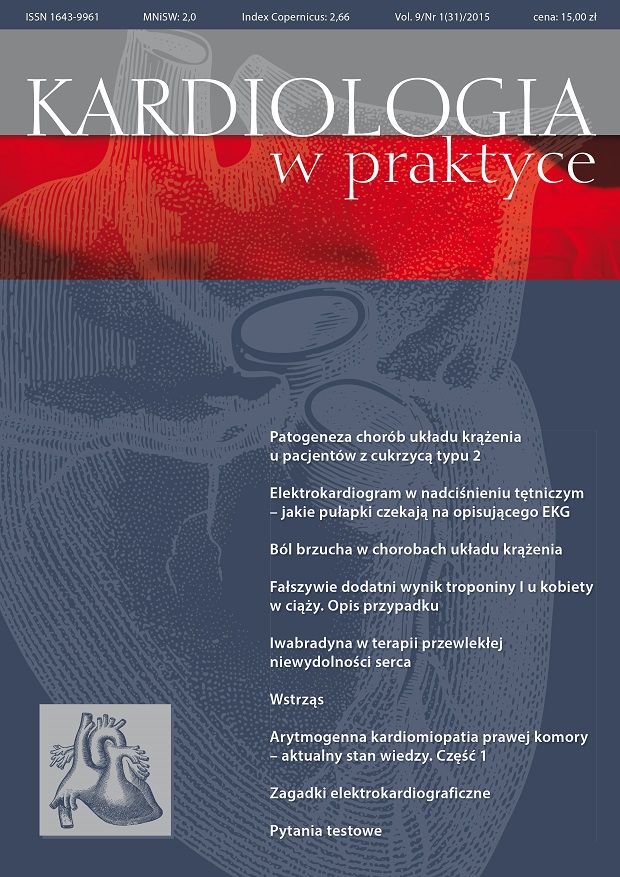Ból brzucha w chorobach układu krążenia Artykuł przeglądowy
##plugins.themes.bootstrap3.article.main##
Abstrakt
Ból brzucha jest nieswoistym objawem występującym w przebiegu wielu chorób. Najczęściej kojarzony jest z dysfunkcją przewodu pokarmowego lub jednostką chorobową wymagającą interwencji chirurgicznej. Nie można jednak zapominać o etiologii sercowo-naczyniowej tego bólu, w której przypadku należy wziąć pod uwagę: zawał dolnej ściany serca, tętniak aorty brzusznej, zator tętnicy krezkowej, chorobę niedokrwienną jelit i wrodzoną wadę serca. Niecharakterystyczny ból brzucha, niemający uchwytnej przyczyny, nie powinien być lekceważony przez żadnego lekarza.
Wczesna diagnostyka i leczenie chorób z pogranicza kardiologii i gastrologii przynoszą ulgę pacjentowi oraz pomagają uniknąć poważnych konsekwencji dla jego zdrowia i życia.
Pobrania
##plugins.themes.bootstrap3.article.details##

Utwór dostępny jest na licencji Creative Commons Uznanie autorstwa – Użycie niekomercyjne 4.0 Międzynarodowe.
Copyright: © Medical Education sp. z o.o. This is an Open Access article distributed under the terms of the Attribution-NonCommercial 4.0 International (CC BY-NC 4.0). License (https://creativecommons.org/licenses/by-nc/4.0/), allowing third parties to copy and redistribute the material in any medium or format and to remix, transform, and build upon the material, provided the original work is properly cited and states its license.
Address reprint requests to: Medical Education, Marcin Kuźma (marcin.kuzma@mededu.pl)
Bibliografia
2. Kulig J., Nowak W.: Ostry brzuch. PZWL, Warszawa 2007: 295-306.
3. Patel H.H., Moore J., Hsu K.A. et al.: Cardioprotection at a distance: mesenteric artery occlusion protects the myocardium via an opioid sensitive mechanism. Journal of Molecular and Cellular Cardiology 2002; 34(10): 1317-1323.
4. Głowiński S.: Patogeneza tętniaków aorty. W: Chirurgia tętnic i żył obwodowych. Noszczyk W. (red.). PZWL, Warszawa 2007: 102-111.
5. Fillinger M.F.: Abdominal Aortic Aneurysms. W: Rutherford’s Vascular Surgery. Cronenwett J.L., Johnston W. (red.). Elsevier 2010.
6. Choke E., Cockerill G., Wilson W.R. et al.: A review of biological factors implicated in abdomina aortic aneurysm rupture. Eur. J. Vasc. Endovasc. Surg. 2005; 30(3): 227-244.
7. Wanhainen A., Themudo R., Ahlstrom H. et al.: Thoracic and abdominal aortic dimension in 70-year-old men and women – a population-based whole-body magnetic resonance imaging (MRI) study. J. Vasc. Surg. 2008; 47(3): 504-512.
8. Sakalihasan N., Limet R., Defawe O.D.: Abdominal aortic aneurysm. The Lancet 2005; 365: 1577-1589.
9. Gruber E.R., Raymond S.A.: Beyond cholesterol: vitamin B6, arteriosclerosis, and your heart. St. Martin Press, New York 1981.
10. Venturi S.: Evolutionary significance of iodine. Current Chemical Biology 2011; 5(3): 155-162.
11. Brown L.C., Powell J.T.: Risk factors for aneurysm rupture in patients kept under ultrasound surveillance. UK Small Aneurysm Trial Participants Ann. Surg. 1999; 230: 289-296; discussion 296-297.
12. Singh K., Bonaa K., Jacobsen B. et al.: Prevalence of and risk factors for abdominal aortic aneurysms in a population-based study. Am. J. Epidemiology 2001; 154(3): 236-244.
13. Lederle F.A., Nelson D.B., Joseph A.M.: Smokers’ relative risk for aortic aneurysm compared with other smoking-related diseases: a systematic review. J. Vasc. Surg. 2003; 38: 329-334.
14. Kuivaniemi H., Shibamura H., Arthur C. et al.: Familial abdominal aortic aneurysms: collection of 233 multiplex families. J. Vasc. Surg. 2003; 37: 340-345.
15. Fink H.A., Lederl F.A., Roth C.S. et al.: The accuracy of physical examination to detect abdominal aortic aneurysm. Arch. Intern. Med. 2000; 160: 833-836.
16. Szmidt J., Jakimowicz T.: Postępy Nauk Medycznych 2012; 1: 37-43.
17. Kertai M.D., Boersma E., Westerhout C.M. et al.: Association between long-term statin use and mortality after successful abdominal aortic aneurysm surgery. The American Journal of Medicine 2004; 116(2): 96-103.
18. Budzyński J., Wasilewski M., Suppan K. et al.: Choroba niedokrwienna jelit w praktyce lekarza rodzinnego. Forum Medycyny Rodzinnej 2011; 5(5): 390-400.
19. Bianchi Porro G., Cremer M., Krejs G. et al.: Gastroenterologia i hepatologia. Wydawnictwo Czelej, Lublin 2003.
20. Simo G., Echenagusia A.J., Camunez F. et al.: Superior mesenteric arterial embolism: local fibrinolytic treatment with urokinase. Radiology 1997; 204: 775-779.
21. Macha M., Gupta D., Molina E. et al.: Congenital heart disease manifested as acute abdominal pain. International Journal of Cardiology 2007; 118(3): 92-93.
